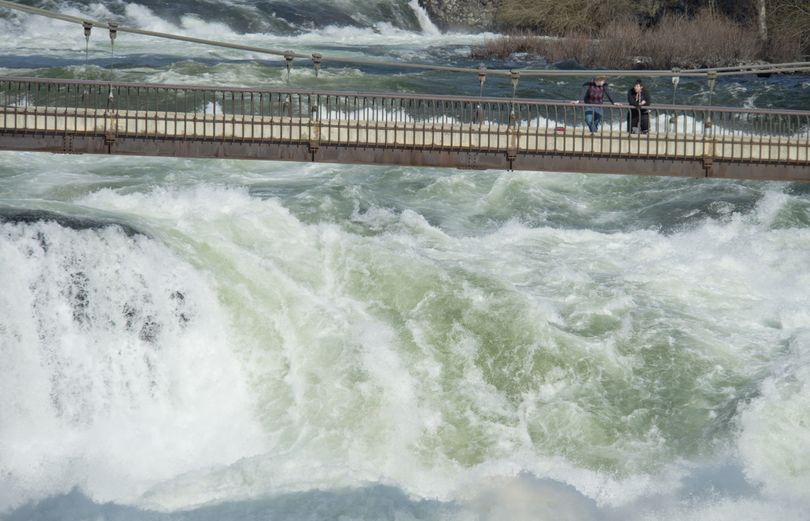Updated: Spokane River flow rules below paddlers’ expectations

UPDATED Jan. 28, 10:55 a.m. with more explanation from Department of Ecology.
RIVERS -- The state of Washington adopted new state rule on instream flows for the Spokane River today, but the levels are likely to disappoint rafters and environmental groups, who had pushed for higher flows, according to a story filed by S-R reporter Becky Kramer.
The instream flow for the river’s main stem varies by season, peaking at 6,500 cubic feet per second in late spring where the river roars through downtown Spokane, and tapering to 850 cubic feet per second in late summer. Each cubic foot of water is about 7 ½ gallons.
- See a media release from the Washington Department of Ecology.
River advocates posted this detailed reaction of their disappointment for the adopted rules:
Today river advocates criticized the Washington Department of Ecology (“Ecology”) for adopting a flow rule for the Spokane River that allows further dewatering of the popular urban river. The Spokane River flows from Lake Coeur d’Alene through eastern Washington to its confluence with the Columbia River. The River supports important fisheries and wildlife, and a vibrant boating and recreation industry. Two thousand people sent comments to the agency opposing the draft rule and asking that river flows be protected.
“This is a terrible decision for the Spokane River and our community,” said Paul Delaney, a co-founder and board member of the Northwest Whitewater Association in Spokane who has been running the river for 35 years. “They never talked to us. They never did the basic use surveys of thousands of people who use the river. And then the agency disregarded basic survey information we provided on boating use of the Spokane River. In the end, the agency’s decision jeopardizes the Spokane River and the water future for this part of eastern Washington.”
The state rule sets flows for the Spokane River, including summertime low flows at 850 cubic feet per second (cfs). Flows that are not protected eventually will be taken for out-of-stream water uses, including Idaho pumpers, the City of Spokane, and the Office of the Columbia River’s Spokane-Rathdrum ASR project.
Although Ecology has defended its decision by pointing to a study that concludes that the 850cfs flow is good for fish, scientists have since pointed out that the study is inadequate for setting flows needed by Spokane River fish. The proposed flows are also inadequate for salmon fisheries, which are proposed for restoration in the Spokane River.
In setting flows, the Department of Ecology failed to consult with boaters who use the Spokane River. American Whitewater undertook a survey asking Spokane River boaters about their flow preferences. Survey results show that all boaters prefer flows higher than 1000 cfs and most prefer flows in the range of 5000 cfs. Flows less than 1000 cfs are considered unfavorable to boaters and can cause damage to some craft.
“Excluding rafters, kayakers, and canoeists in setting flows is a dangerous move for Washington State’s rivers,” said Rachael Paschal Osborn, senior water policy advisor with the Center for Environmental Law & Policy (CELP). “Water may be political currency, but we also have stewardship responsibilities to protect the state’s rivers.”
Ecology also failed to do basic assessment of the scenic values of the Spokane River as it flows through the gorge. CELP released an atlas of 37 key observation points of the Spokane River’s downriver reach, starting at the Monroe Street bridge in downtown Spokane. The study documents five different flows ranging from 2,800 to 1,000 cfs.
“We need to protect our rivers; the water frontier is over,” said Osborn. “The law is clearly on the side of the Spokane River: ‘Perennial rivers and streams of the state shall be retained with base flows necessary to provide for preservation of wildlife, fish, scenic, aesthetic and other environmental values, and navigational values.’”
Brook Beeler, DOE communication manager, submitted further explanation from agency officials:
The rule to preserve and protect flow was written to balance all of the community’s needs for the river, including fish, recreation, water use and hydropower.
The river is a complex system and its flow is dependent on a variety of factors. They include seasonal weather, groundwater use, and operation of hydropower facilities on the river. The higher flows requested by many recreational users have rarely been seen in summer on the Spokane River since the Post Falls Dam was constructed in 1907.
It is important to note that instream flow rules do not add water to the river — they are a regulatory threshold to determine whether there is water available for new uses. The rule doesn’t require business, water providers or local government to add water to the river. In order to increase river flow, the hydropower operations on the river would need to change, which is governed by the Federal Energy Regulatory Commission license process – not the instream flow rule.
Existing water rights like the city of Spokane’s right and other water providers cannot be affected by the rule. New requests for water in Washington will be individually evaluated to determine if water is available and in the public’s interest to issue new water use permits.
We are committed to working with local governments, environmental advocates, local businesses and the community on water management decisions to preserve a clean and flowing Spokane River.
For more information, see these links:
